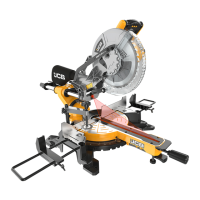
Do you have a question about the jcb JCB-MS-254SB-L and is the answer not in the manual?
Details on required safety gear like ear defenders, eye protection, and gloves.
Precautions for using the Class 2 laser, avoiding direct eye exposure and pointing.
Information on wood dust exposure risks and directing users to P65Warnings.ca.gov for details.
Guidelines for maintaining a clean, well-lit, and safe work environment free from distractions.
Rules for safe use of power tools, including plugs, grounding, cords, and wet conditions.
Advice on staying alert, using common sense, and wearing appropriate safety equipment.
Steps to ensure the tool is off before connecting to power or handling.
Instructions on proper use, maintenance checks, and care of the power tool.
Specifies the saw is for wood/wood-like products and advises on blade selection and speed.
Rules for clamping workpieces, keeping hands away from the blade, and ensuring stability.
Instructions on pushing the saw correctly and avoiding hazardous hand placements.
Checking workpieces for defects, ensuring stability and proper setup.
Guidelines for safe cutting, handling jammed components, and post-cut actions.
Do not use cracked blades; ensure they are clean and properly fitted.
Ensure blades meet tool requirements and are used for the correct materials.
Do not look directly into the laser beam or its path; avoid pointing at reflective surfaces.
Do not open the laser module; consult authorized personnel for repairs or battery removal.
Identification of main parts like handle, switches, guards, table, and dust bag.
Identification of scales, pointers, depth limiters, laser components, and guide bars.
Details on AC motor, power, blade size, number of teeth, and cutting dimensions.
Information on mitre range, bevel cut, weight, protection class, and workpiece requirements.
Measured sound pressure and sound level values with uncertainty, and hearing protection advice.
Note that actual noise may vary based on usage, workpiece type, and operational cycle.
Specifies the saw is for wood/plastic crosscutting; warns against other materials and cutting-off wheels.
Identifies potential hazards like blade contact, kick-back, fracturing, and dust emissions.
Steps for securely setting up the machine and ensuring all safety devices are fitted.
Ensure the ON/OFF switch functions correctly before connecting to power.
Ensure all assembly is complete and instructions are read before connecting power.
Detailed steps for assembling components like the turntable, clamping device, and supports.
How to set the angle stop for a precise 90-degree crosscut.
Instructions for operating the ON/OFF trigger switch and lock-off lever.
How to operate the laser ON/OFF switch as required.
How to adjust locking screws and extension blocks for various crosscuts.
Instructions for placing the workpiece on the table and using the clamping device.
Procedure for performing cuts with the drag guide fixed or not fixed.
Adjusting extension blocks and turntable for 0° to 45° crosscuts.
How to precisely set the machine head and angle stop for a 45° mitre cut.
Adjusting angle screws and pointers for precise bevel cuts.
Setting extension blocks and turntable for combined bevel and mitre cuts.
Instructions on how to attach, use, and empty the sawdust collection bag.
How to adjust the screw for limiting the cutting depth.
Steps involving the blade guard, spindle lock, and accessing the flange bolt.
Procedure for removing the old blade and installing a new one with correct orientation.
Routine cleaning, oiling of rotary parts, and avoiding corrosive cleaning agents.
How and when to inspect carbon brushes for wear and the procedure for replacement.
Guidelines for connecting the tool to the power supply and compliance with regulations.
Information on motor overload protection and warnings regarding damaged electrical cables.
Details on mains voltage, extension cables, and instructions for safely transporting the saw.
Guidelines for storing the machine and accessories in a dark, dry, and frost-free environment.
Advice on recycling packaging and proper disposal of old electrical equipment.
Details on the 12-month warranty period, proof of purchase, and how to make a claim.
Lists components not covered by warranty and disclaims liability for injuries or damages.
Lists product identification, safety standards compliance, and manufacturer information.
Contact details for test results, manufacturing, and testing locations and dates.